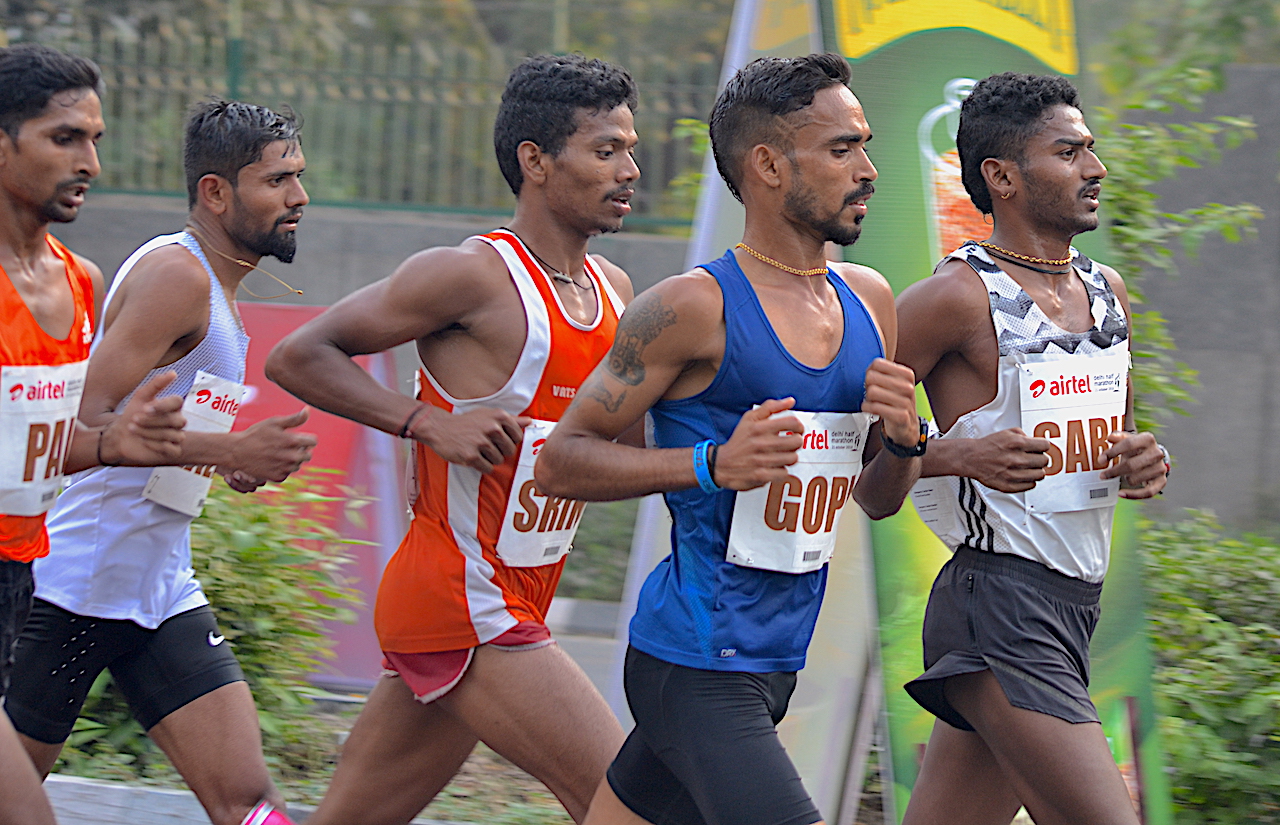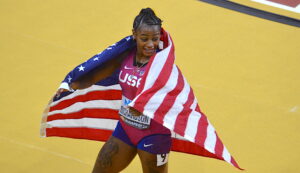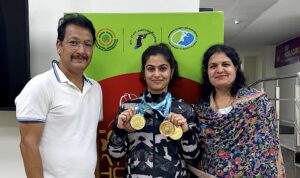
A file photograph of T Gopi running shot during the Airtel Delhi Half Marathon 2018. Photo: G Rajaraman
For long, Surendra Singh Bhandari’s life has been consumed by one figure: 2:12:00. Shivnath Singh’s national record for marathon, has inspired and mocked at the country’s runners since he set it in May 1978, a few months before Surendra Singh was born. A solid distance runner in his time, he soon turned his attention to training others achieve this milestone.
He now has a new number to think of as well: 2:11:30. It is the time an Indian marathoner will have to clock to meet the IAAF’s entry standards for the 2020 Olympic Games in Tokyo. Is it a bridge too far or will one of his trainees, Thonakal Gopi or Nitendra Singh Rawat, close the gap that has teased them so far.
Gopi, who won the Asian Championship in Dongguan, China, on November 26, 2017, finished 11th in the Seoul Marathon last monthc, completing the course in 2:13:39, the closest an Indian has got to the National record in many a year. He holds the edge in his friendly rivalry with fellow-Armyman Nitendra Singh Rawat.
London marked the first time that a top Indian marathoner competed with the elite runners in one of the world’s marathon majors. Finishing 27th in a rich field is not a mean achievement at all. But hopes of taking a crack at Shivnath Singh’s record remained unrealised as Nitendra Singh Rawat finished in 2:15:59, 41 seconds slower than his own personal best clocked in February 2016.
“Should he not have reached London earlier? Do they not know anything about acclimatisation?” my friend asked me even as we tracked the race online. I did not have a first-hand idea why Nitendra Singh Rawat had decided to reach London just a couple of days before the race. Yet, I raked my mind for answers. Stay in London is expensive, I suggested. Quite unconvincingly.
The following day, Hindustan Times’ reporter Navneet Singh’s record of his interaction with Nitendra Singh Rawat offered the better reason. “Running became very tough after the 30km mark. I finished with great difficulty,” he said, pointing out that his calf muscles started stiffening after 27 or 28km. There was a gentle reference to training in Ranikhet (elevation 1869m).
I should have remembered that it was not the first time that Indian distance runners moved from high altitude training for competitions with little time left for their races. For the 2018 Asian Games in Jakarta, the nation’s middle- and long-distance runners went from the Thimpu Athletics Track and Field Centre (elevation 2334m) in Bhutan.
Indeed, the was a deliberate and considered decision made by the athlete and his coach.
“Going earlier might have reduced the impact of his training at high altitude,” coach Surender Singh Bhandari said. “He was training for a while in Ranikhet and it made sense to reach London just a couple of days before the race. He was ready for the race-day temperature as well. He was on course for a 2:13 finish but pain in his calf muscles near the 30km mark slowed him down.”
High altitude training has been in vogue since the Mexico City Olympic Games in 1968 but there seems to be no universal agreement on the training techniques or the exact timelines for physiological benefits (when and how long does the impact of training at a height last?). Perhaps there is a need for an India-based study.
The trick perhaps is to train right even at altitude. The time spent reading up on the impact of altitude training threw up some insights, none more interesting than the argument that while adapting to higher reaches will help a runner improve his oxygen carrying capacity, it does not necessarily mean running faster times at sea level.
Nitendra Singh Rawat, meanwhile, had reached every 5km milestone inside 16m till he got to 25km. Thereafter, he dropped pace and needed more than 16 minutes for the three remaining such slabs. From this distance, it was evident that something had happened to slow him down noticeably and with each passing minute, it was obvious that Shivnath Singh’s record would remain intact.
It was on May 28, 1978 that Shivnath Singh set the national mark at 2:12:00 in Jalandhar (or was it 2:11:59?), having clocked a more modest 2:16:22 in the Montreal Olympic Games in July 1976 where he finished 11th in a field of 67 runners. These two achievements – the national mark and the finish just outside the top 10) – gave him the status of a legend in India.
Yet, Nitendra Singh Rawat would have been encouraged that he got to the 30km mark in 1:34:58, just a few seconds shy of the time Gopi had been credited with in the Seoul Marathon last month. In clocking 2:13:39 in Seoul, the second fastest marathon by an Indian, Gopi had got past the 30km mark in 1:34:14 but the calf muscles would not let him get even his personal best.
The good thing is that Nitendra Singh Rawat will return to the National camp, something that had seemed to be a receding dream after his 2:22:52 marathon in the 2016 Olympic Games in Rio de Janeiro. An exit from the camp meant that he had to share accommodation with others outside the Sports Authority of India campus, cook his own meals and then train with Bhandari.
Indeed, Bhandari’s quest to get one of his trainees to break the National record continues. He is pleased that Gopi Thonakal and Nitendra Singh Rawat have got to within challenging distances of that Holy Grail of distance running in India. And he senses that the day is not far when this dream of his will come true.







